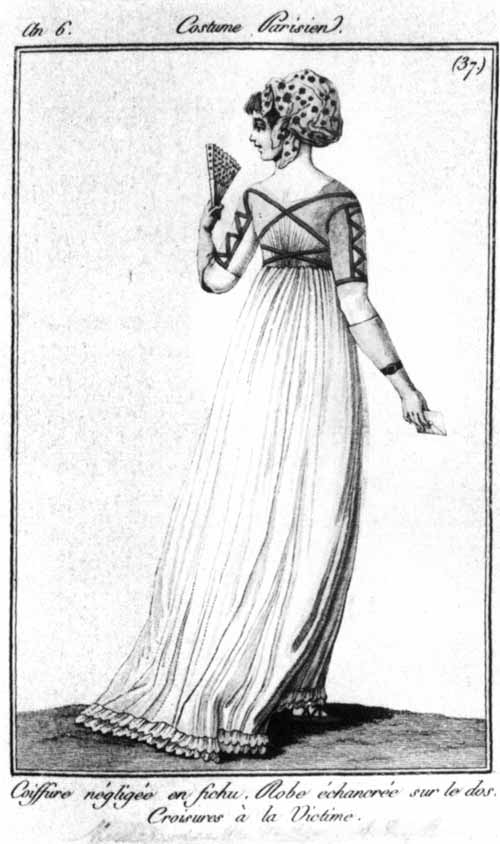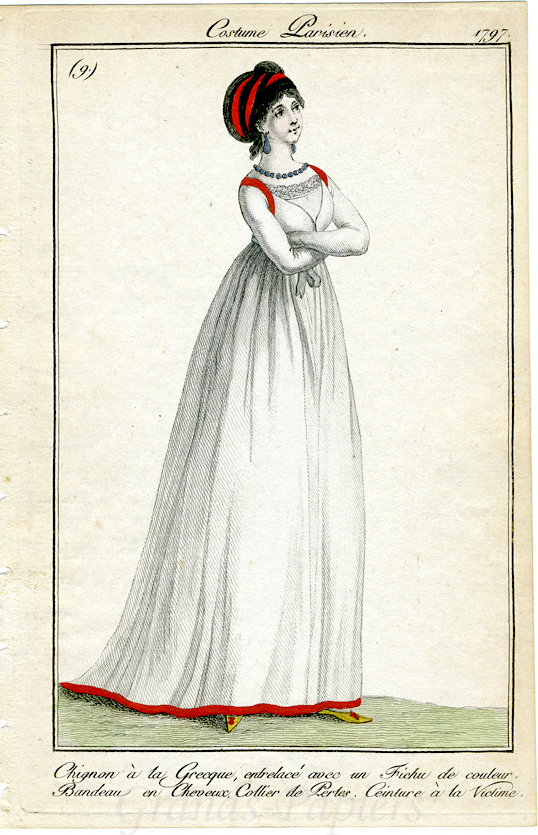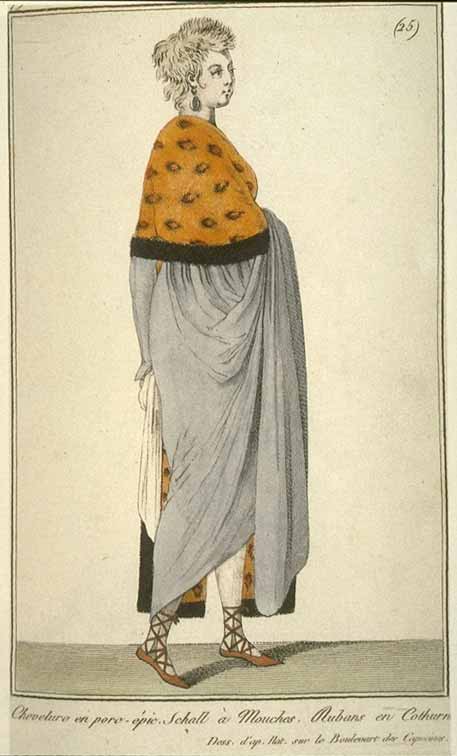Fashion Victime
May 17th, 2011
There were a number of books and articles published in the mid to late 19th century describing a phenomenon known as Bals des Victimes, that may or may not have taken place in the days following Robespierre’s death and the reinstatement of the French nobility. Here’s a relatively early one from Histoire de la Révolution et de l’Empire, published in 1847.

Unfortunately, my French, limited to begin with, is quite rusty. I believe the gist of this page is as follows:
At the far end of the Champs-Elysees, the crowd of dancers formed on the lawn of some garden that had been confiscated during the revolution, and there were some others around the old gallows of the guillotine. It didn’t stop at the beginning of the red light district either — there were lots of parties open to the public: for five days. They transformed the ancient cemetery of Saint-Sulpice into a dance floor, etc., etc. … In the outlying areas of the city, a great number of pastoral-themed parties were organized, frequented by the latest [lower??] classes. The upper classes, who had been reinstated to the bourgeoisie and the nobility, came up with the Victim’s ball. These were exclusive — in order to get in you had to have lost a parent to the guillotine. Upon entering, it was fashionable to perform a salutation with your head and shoulders imitating decapitation; this was called the Victim’s Greeting.
It goes on, but I cannot.
Here, from an 1867 book about the Empress Josephine, is a description in English:
This was especially the case at the so-called victim balls (bals a la victime) which were given by the heirs, the sons and fathers of those who had perished by the guillotine. People gathered together in brilliant entertainments and balls to the honor and memory of the executed ones. Every one who could pay the large fee of admission to these bals a la victime were permitted to enter. Those who came there, not for pleasure, but to honor their dead, showed this intention by their clothing, and especially by the arrangement of their hair. To remind them that those who had been led to the guillotine had had their hair cut close, gentlemen now had theirs cut short, and the dressing of the hair a la victime was for gentlemen as much a fashion as the dressing of the hair a la Titus (the Roman emperor) was for the ladies. Besides this, the heirs of the victims wore some token of the departed ones, and ladies and gentlemen were seen in the blood-stained garments which their relatives had worn on their way to the scaffold, and which they had purchased with large sums of money from the executioner, that lord of Paris.
As you may guess, I am particularly interested in the fashions associated with this legendary (historians seems to disagree as to whether these events actually took place or were merely figments of later romantic imaginations) custom. A friend who grew up in Paris told me about men and women who wore red ribbons tied round their necks where the blade would have fallen, and there was a fashion for women to wear close cropped hair in imitation of someone about to be executed. Classically inspired robes, like the dress I am in the midst of making right now, were also popular. Some sources claim that attendees wore mourning clothes, including crape bands about the arm. However I don’t know if that type of mourning dress was even invented as early as the turn of the 19th century, which would mark those accounts at least as pure fabrication.
Here are a few fashion plates from late 18th, early 19th century France. Notice how each refers to various styles a la victime?

Very Grecian!
Notice the ribbons bound about her feet — some Victimes wore no shoes, just ribbons tied around their feet and ankles.



Wow — heady stuff (and terrifying). I can only imagine how insane everything must have felt at the time.
Sort of like the decadence at the end of the 19th century…only for very different reasons. I know it’s morbid, but I was thinking how much of a hoot it would be to hold a bal des victimes…I could definitely see it as a DOV theme too! But it would probably be in bad taste. I guess I will file that in the same folder with my “19th-Century Hand-Sewing: Make Your Own Shroud” workshop.
HAH! I know a lot of people who would go to the shroud workshop (note: they are all goths).
Yes, I wonder how much of it is a composite revisionist history assembled some decades later? It does seem like some of Paris was trying to come to terms with the horrors of the revolution. What would a 20th century version be?
I’m sure there have been similar myths developed around the events taking place in Nazi Germany for example, or perhaps some of the genocides in the middle east and Africa, though I don’t know enough about those regions/eras to give any specific examples. All it takes is one person with questionable judgement to do something once, and the legend begins to grow…
I have such a questionable 20th century tale to tell you both about, but I won’t do it online…
We are all ears — pick your medium!